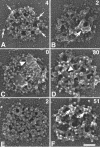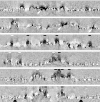Distribution of postsynaptic density (PSD)-95 and Ca2+/calmodulin-dependent protein kinase II at the PSD
- PMID: 14657186
- PMCID: PMC6741048
- DOI: 10.1523/JNEUROSCI.23-35-11270.2003
Distribution of postsynaptic density (PSD)-95 and Ca2+/calmodulin-dependent protein kinase II at the PSD
Abstract
Postsynaptic densities (PSDs) contain proteins that regulate synaptic transmission. We determined the positions of calcium/calmodulin-dependent protein kinase II (CaMKII) and PSD-95 within the three-dimensional structure of isolated PSDs using immunogold labeling, rotary shadowing, and electron microscopic tomography. The results show that all PSDs contain a central mesh immediately underlying the postsynaptic membrane. Label for PSD-95 is found on both the cytoplasmic and cleft sides of this mesh, averaging 12 nm from the cleft side. All PSDs label for PSD-95. The properties of CaMKII labeling are quite different. Label is virtually absent on the cleft sides of PSDs, but can be heavy on the cytoplasmic side at a mean distance of 25 nm from the cleft. In tomograms, CaMKII holoenzymes can be visualized directly, appearing as labeled, tower-like structures reflecting the 20 nm diameter of the holoenzyme. These towers protrude from the cytoplasmic side of the central mesh. There appears to be a local organization of CaMKII, as judged by fact that the nearest-neighbor distances are nearly invariant over a wide range of labeling density for CaMKII. The average density of CaMKII holoenzymes is highly variable, ranging from zero to values approaching a tightly packed state. This variability is significantly higher than that for PSD-95 and is consistent with an information storage role for CaMKII.
Figures









References
-
- Barria A, Muller D, Derkach V, Griffith LC, Soderling TR ( 1997) Regulatory phosphorylation of AMPA-type glutamate receptors by CaMKII during long-term potentiation. Science 276: 2042-2045. - PubMed
-
- Cho KO, Hunt CA, Kennedy MB ( 1992) The rat brain postsynaptic density fraction contains a homolog of the Drosophila discs-large tumor suppressor protein. Neuron 9: 929-942. - PubMed
Publication types
MeSH terms
Substances
Grants and funding
LinkOut - more resources
Full Text Sources
Miscellaneous
